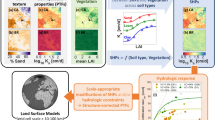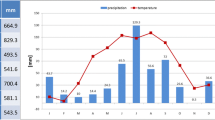Abstract
Pedotransfer functions are classes of models used to estimate soil water holding characteristics based on commonly measured soil composition data as well as other soil characteristics. These models are important on their own but are particularly useful in modeling agricultural crop yields where only soil composition is known. In this article, an additive, multivariate spatial process model is introduced that offers the flexibility to capture the complex structure typical of the relationship between soil composition and water holding characteristics, thus defining a new form of pedotransfer function. Further, the uncertainty in the soil water characteristics is quantified in a manner to simulate ensembles of soil water profiles. Using this capability, a small study is conducted with the CERES maize crop model to examine the sources of variation in the yields of maize. Here it is shown that the interannual variability of weather is a more significant source of variation in crop yield than the uncertainty in the pedotransfer function for two specific soil textures.
Similar content being viewed by others
References
Aitchison, J. (1987), The Statistical Analysis of Compositional Data, London: Chapman and Hall.
Breiman, L., and Friedman, J. H. (1985), “Estimating Optimal Transformations for Multiple Regression and Correlations” (with discussion), Journal of the American Statistical Association, 80, 580–619.
Buja, A., Hastie, T. J., and Tibshirani, R. J. (1989), “Linear Smoothers and Additive Models” (with discussion), The Annals of Statistics, 17, 453–555.
Cressie, N. A. C. (1990), Reply to Wahba’s letter, The American Statistician, 44, 256–258.
— (1991), Statistics for Spatial Data, New York: Wiley.
de Boor, C. (1978), A Practical Guide to Splines, New York: Springer-Verlag.
Dempster, A. P., Laird, N. M., and Rubin, D. B. (1977), “Maximum Likelihood From Incomplete Data via the EM Algorithm” (with discussion), Journal of the Royal Statistical Society, Ser. B 39, 1–37.
Gijsman, A. J., Jagtap, S. S., and Jones, J. W. (2002), “Wading Through a Swamp of Complete Confusion: How to Choose a Method for Estimating Soil Water Retention Parameters for Crop Models,” European Journal of Agronomy, 18, 75–105.
Green, P.J., and Silverman, B. W. (1994), Nonparametric Regression and Generalized Linear Models: A Roughness Penalty Approach, London: Chapman and Hall.
Kent, J. T., and Mardia, K. V. (1994), “The Link Between Kriging and Thin Plate Spline Splines,” in Probability, Statistics, and Optimization, ed. F. P. Kelly, New York: Wiley, pp. 325–339.
Kitandidis, P. K. (1997), Introduction to Geostatistics: Applications in Hydrogeology, New York: Cambridge University Press.
Jagtap, S. S., Lall, U., Jones, J. W., Gijsman, A. J., and Ritchie, J. T. (2003), “A Dynamic Nearest Neighbor Method for Estimating Soil Water Parameters” Transactions of the American Society of Agricultural Engineers, 47, 1437–1444.
Jones, C. A., and Kiniry, J. R. (1986), CERES-Maize: A Simulation Model of Maize Growth and Development, College Station, TX: Texas A & M University Press.
Mardia, K. V., Kent, J. T., and Bibby, J. M. (1979), Multivariate Analysis, London: Academic Press.
McCulloch, C. E., and Searle, S. R. (2000), Generalized, Linear, and Mixed Models, New York: Wiley.
Mearns, L. O., Rosenzweig, C., and Goldberg, R. (1996), “The Effect of Change in Daily and Internual Variability on CERES-Wheat: A Sensitivity Study,” Climatic Change, 32, 257–292.
— (1997), “Mean and Variance Change in Climate Scenarios: Methods, Agricultural Applications, and Measures of Uncertainty,” Climatic Change, 35, 367–396.
Minansy, B., McBratney, A. B., and Bristow, K. L. (1999), “Comparison of Different Approaches to the Development of Pedotransfer Functions for Water Retention Curves,” Geoderma, 93, 225–253.
Nychka, D. W. (2000), “Spatial-Process Estimates as Smoothers,” in Smoothing and Regression: Approaches, Computation, and Application, ed. M. G. Schimek, New York: Wiley.
Pachepsky, Y. A., Rawls, W. J., and Timlin, D. J. (1999), “The Current Status of Pedotransfer Functions: Their Accuracy, Reliability and Utility in Field- and Region-Scale Modeling,” in Assessment of Non-Point Source Pollution in the Vadose Zone, eds. D. L. Corwin, K. M. Loague, and T. R. Ellsworth, Geophysical Monograph 108, Washington, DC: American Geophysical Union.
Ratliff, L. F., Ritchie, J. T., and Cassel, D. K. (1983), “Field-Measured Limits of Soil Water Availability as Related to Laboratory-Measured Properties,” Soil Science Society of America Journal, 47, 770–775.
Rawls, W. J., Gish, T. J., and Brakensiek, D. L. (1991), “Estimating Soil Water Retention from Soil Physical Properties and Characteristics,” Advances in Agronomy, 16, 213–234.
Ritchie, J. T., Ratliff, L. F., and Cassel, D. K. (1987), “Soil Laboratory Data, Field Descriptions and Filed Measured Soil Water Limits for Some Soils of the United States,” ARS Technical Bulletin. ARS Agriculture Research Service and Soil Conservation Service/Stat Agriculture Experimental Stations, Temple, Texas.
Ruppert, D., Wand, M. P., and Carroll, R. J. (2003), Semiparametric Regression, Cambridge, U.K. Cambridge University Press.
Scott, D. W. (1992), Multivariate Density Estimation: Theory, Practice, and Visualization, New York: Wiley.
Stein, M. L. (1999), Interpolation of Spatial Data: Some Theory for Kriging, New York: Springer-Verlag.
Timlin, D. J., Pachepsky, Y. A., Acock, B., and Whisler, F. (1996), “Indirect Estimation of Soil Hydraulic Properties to Predict Soybean Yield Using GLYCIM,” Agricultural Systems, 52, 331–353.
Wahba, G. (1990a), Spline Models for Observational Data. Philadelphia: SIAM.
— (1990b), Letter to the Editor, The American Statistician, 44, 256.
Wand, M. P., and Jones, M. C. (1995), Kernel Smoothing, London: Chapman and Hall.
Author information
Authors and Affiliations
Corresponding author
Rights and permissions
About this article
Cite this article
Sain, S.R., Jagtap, S., Mearns, L. et al. A multivariate spatial model for soil water profiles. JABES 11, 462–480 (2006). https://doi.org/10.1198/108571106X154957
Received:
Revised:
Issue Date:
DOI: https://doi.org/10.1198/108571106X154957




